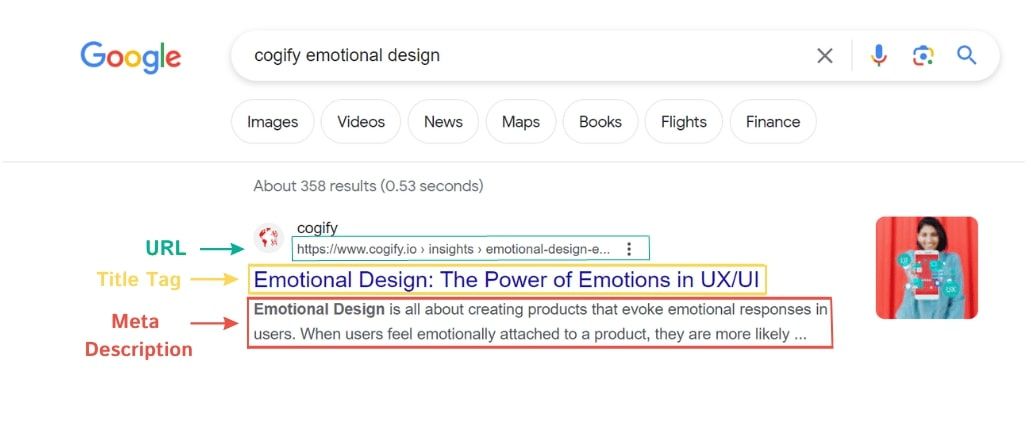At the heart of SEO (Search Engine Optimisation) lies the strategic use of keywords. They play a pivotal role in guiding search engines and audiences to your content. However, just conducting keywords research isn’t enough. Knowing how to integrate these keywords seamlessly is the key.
Title tags, meta descriptions, and URLs
Title Tags: One of the most influential ranking factors for search engines. Including relevant keywords here ensures that search engines understand the core topic of your content. But it's not just about SEO; users also look at title tags to get a glimpse of what to expect from the page. Ensuring your keywords are in the title can result in higher organic click-through rates.
Meta Descriptions: These brief summaries give both search engines and users an overview of your page's content. A well-crafted meta description with the right keyword can act as a sales pitch, urging users to click on your content from the search results. While it might not directly impact search rankings, its influence on click-through rates can't be ignored.
URLs: Clean, concise, and descriptive URLs can improve user experience. When your URL contains the targeted keyword, it provides an added reassurance to users about the relevancy of the content. Not to mention, it gives search engines another clue about the topic of your content.

Headers (H1, H2, H3)
The Importance of Headers: Headers break down your content, making it skimmable and more digestible for readers. They are like signposts that guide readers through your content, highlighting the main points and subpoints.
Incorporating Keywords: Using keywords in headers, especially the H1 (which is typically the title of your page or post), signals to search engines the hierarchy of information. The H1 tag should capture the main theme, while H2 and H3 tags can be used for subtopics and related points. Remember, while it's beneficial to include keywords in these headers, they should be integrated naturally, ensuring the content remains user-centric.

Body Content
The Role of Keywords: Within the body of your content, keywords act as anchors, emphasizing the main topics you're addressing. They give context to your content, helping search engines index it appropriately.
Ensuring Natural Flow: While it's essential to include keywords, it's equally important to ensure they're woven seamlessly. Force-feeding keywords can disrupt the reading experience, making the content feel mechanical. Instead, focus on the narrative. If a keyword fits naturally, include it. If not, look for opportunities where it might, or consider if its synonym might be a better fit.
User Experience Above All: The end goal of any piece of content should be to inform, entertain, or solve a problem for the reader. Keywords are tools to help achieve this goal by making your content more discoverable, but they shouldn't compromise the quality or integrity of your message.

Avoid Keyword Stuffing
Keyword Stuffing is the practice of excessively using keywords in content, with the primary aim to manipulate search engine rankings. It often results in content that's unreadable and offers little value to the user.
Why is Keyword Stuffing bad for SEO and user experience?
Keyword stuffing may give you a temporary boost in rankings, but search engines like Google have become smarter. They can detect and penalise this practice. Overdoing keywords not only jeopardizes your SEO efforts but also diminishes the user experience, driving potential customers away. Learn how to protect your website against Black Hat SEO and Search Engine Penalties here.

Tips to Maintain Keyword Density Without Overdoing It:
- Use synonyms: Instead of repeating the same keyword, use its synonyms. This not only keeps the content fresh but also caters to different search queries.
- Prioritise user experience: Write for your audience first, search engines second. Content should be engaging and informative.
- Use tools: There are plenty of SEO tools out there that can help you analyse keyword density. Use them to ensure you’re striking the right balance.
While keywords are undeniably vital for SEO, how they're used matters the most. Strive for a balance where your content is optimised for search engines while still being valuable and readable to your audience. Avoid the pitfalls of black hat techniques, and focus on genuine, quality content. After all, SEO is not just about visibility; it's about connecting with your audience in a meaningful way.
Let's Elevate Your SEO Game!
Navigating the intricacies of SEO can seem daunting, but with the right guidance, your content can shine both for search engines and your audience. Our team of SEO professionals is well-versed in the latest strategies and best practices. Whether you're new to SEO or looking to refine your strategy, Cogify is here to assist every step of the way.






